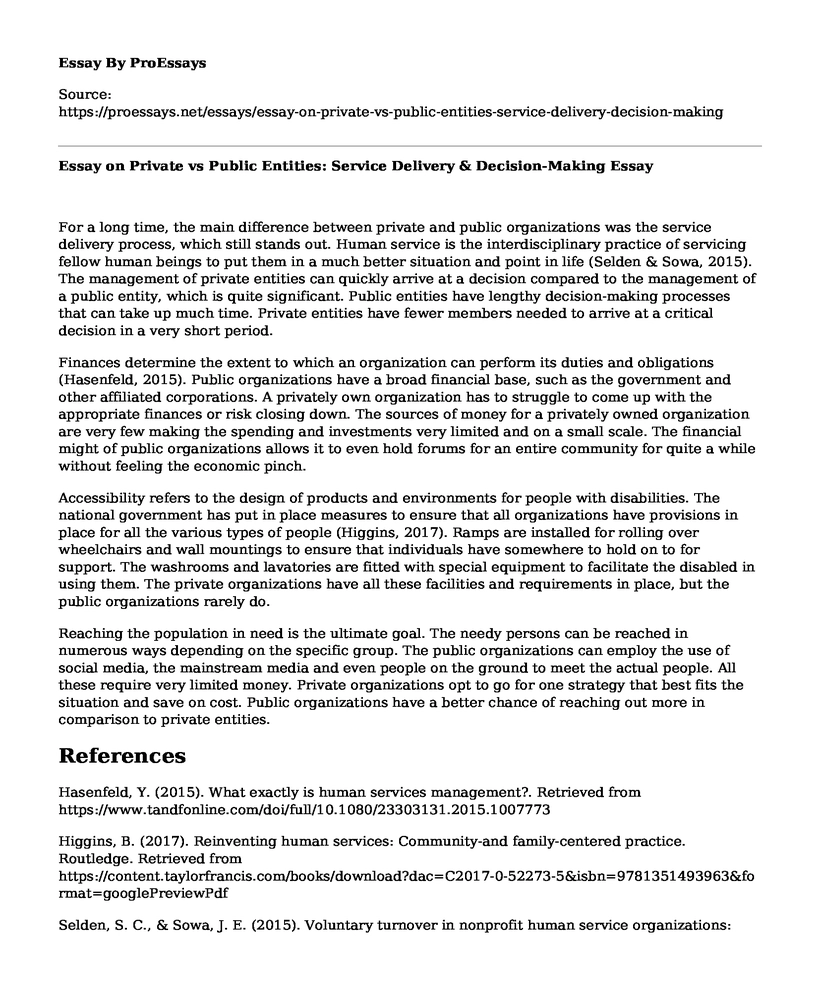For a long time, the main difference between private and public organizations was the service delivery process, which still stands out. Human service is the interdisciplinary practice of servicing fellow human beings to put them in a much better situation and point in life (Selden & Sowa, 2015). The management of private entities can quickly arrive at a decision compared to the management of a public entity, which is quite significant. Public entities have lengthy decision-making processes that can take up much time. Private entities have fewer members needed to arrive at a critical decision in a very short period.
Finances determine the extent to which an organization can perform its duties and obligations (Hasenfeld, 2015). Public organizations have a broad financial base, such as the government and other affiliated corporations. A privately own organization has to struggle to come up with the appropriate finances or risk closing down. The sources of money for a privately owned organization are very few making the spending and investments very limited and on a small scale. The financial might of public organizations allows it to even hold forums for an entire community for quite a while without feeling the economic pinch.
Accessibility refers to the design of products and environments for people with disabilities. The national government has put in place measures to ensure that all organizations have provisions in place for all the various types of people (Higgins, 2017). Ramps are installed for rolling over wheelchairs and wall mountings to ensure that individuals have somewhere to hold on to for support. The washrooms and lavatories are fitted with special equipment to facilitate the disabled in using them. The private organizations have all these facilities and requirements in place, but the public organizations rarely do.
Reaching the population in need is the ultimate goal. The needy persons can be reached in numerous ways depending on the specific group. The public organizations can employ the use of social media, the mainstream media and even people on the ground to meet the actual people. All these require very limited money. Private organizations opt to go for one strategy that best fits the situation and save on cost. Public organizations have a better chance of reaching out more in comparison to private entities.
References
Hasenfeld, Y. (2015). What exactly is human services management?. Retrieved from https://www.tandfonline.com/doi/full/10.1080/23303131.2015.1007773
Higgins, B. (2017). Reinventing human services: Community-and family-centered practice. Routledge. Retrieved from https://content.taylorfrancis.com/books/download?dac=C2017-0-52273-5&isbn=9781351493963&format=googlePreviewPdf
Selden, S. C., & Sowa, J. E. (2015). Voluntary turnover in nonprofit human service organizations: The impact of high-performance work practices. Human Service Organizations: Management, Leadership & Governance, 39(3), 182-207. Retrieved from https://www.tandfonline.com/doi/abs/10.1080/23303131.2015.1031416
Cite this page
Essay on Private vs Public Entities: Service Delivery & Decision-Making. (2023, Mar 02). Retrieved from https://proessays.net/essays/essay-on-private-vs-public-entities-service-delivery-decision-making
If you are the original author of this essay and no longer wish to have it published on the ProEssays website, please click below to request its removal:
- English Football and Its Governance: Governance Issues Among Stakeholders Essay
- Scrum Process Article Analysis Essay
- Leadership and Organizational Development Principles and Applications Paper Example
- Paper Example on Comparing Management Styles of Steve Jobs and Tim Cook at Apple Inc
- Secure Your Business: Essay Sample on Implementing Effective Data Security Programs
- Essay Sample on Leaders Who Changed the World: Gandhi, Mandela, and More
- Essay on Organizational Culture & Change Mgmt: A Structured Approach to Transitions







